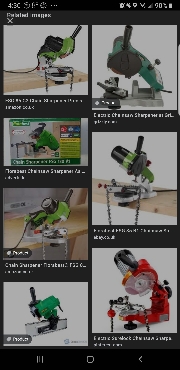Summary
Grizzly is known for their stationary wood and metal working machines. I was surprised to see them selling a saw chain grinder (model T28959 - Electric Chainsaw Sharpener) while looking for something else on line, and was interested in trying one.


I was generally impressed with the unit I received, until I noted excessive run-out (described further below). I contacted Grizzly and they sent a replacement unit right away. The second unit had the same problem. Grizzly described this as 'an outlier experience' and referred me to the 'numerous 5-star reviews' on their website.
I was not able to use the product for sharpening, due to the run-out. If you are able to get one without this problem, you may find it satisfactory to use. Please take the time to read the reviews, posted on their website, for additional comments and perspectives.
Philbert
Grizzly is known for their stationary wood and metal working machines. I was surprised to see them selling a saw chain grinder (model T28959 - Electric Chainsaw Sharpener) while looking for something else on line, and was interested in trying one.


I was generally impressed with the unit I received, until I noted excessive run-out (described further below). I contacted Grizzly and they sent a replacement unit right away. The second unit had the same problem. Grizzly described this as 'an outlier experience' and referred me to the 'numerous 5-star reviews' on their website.
I was not able to use the product for sharpening, due to the run-out. If you are able to get one without this problem, you may find it satisfactory to use. Please take the time to read the reviews, posted on their website, for additional comments and perspectives.
Philbert








